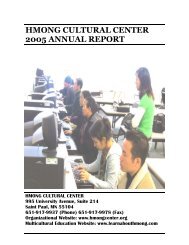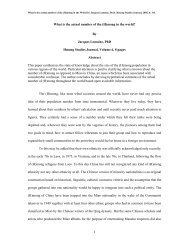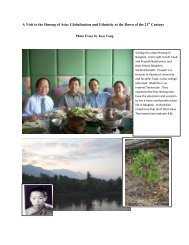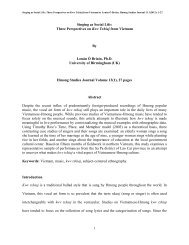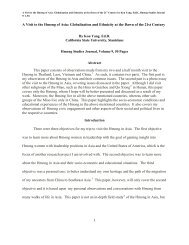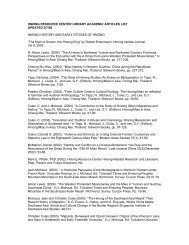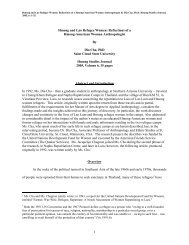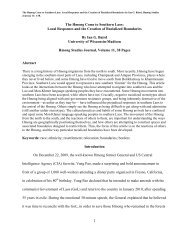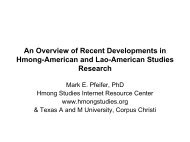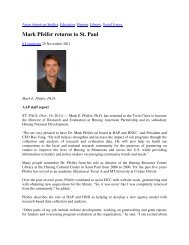Hmong Resettlement in French Guiana By Patrick F. Clarkin, PhD ...
Hmong Resettlement in French Guiana By Patrick F. Clarkin, PhD ...
Hmong Resettlement in French Guiana By Patrick F. Clarkin, PhD ...
You also want an ePaper? Increase the reach of your titles
YUMPU automatically turns print PDFs into web optimized ePapers that Google loves.
<strong>Hmong</strong> <strong>Resettlement</strong> <strong>in</strong> <strong>French</strong> <strong>Guiana</strong> by <strong>Patrick</strong> F. Clark<strong>in</strong>, Ph.D., <strong>Hmong</strong> Studies Journal, 2005, 6: 1-27.<strong>Hmong</strong> <strong>Resettlement</strong> <strong>in</strong> <strong>French</strong> <strong>Guiana</strong><strong>By</strong><strong>Patrick</strong> F. Clark<strong>in</strong>, <strong>PhD</strong>Assistant Professor of AnthropologyUniversity of Massachusetts Boston<strong>Hmong</strong> Studies Journal, Volume 6, 27 PagesAbstractWith<strong>in</strong> the <strong>Hmong</strong> refugee diaspora, the <strong>Hmong</strong> of <strong>French</strong> <strong>Guiana</strong> are fairly unique <strong>in</strong> that many haveachieved economic autonomy through market farm<strong>in</strong>g while also resid<strong>in</strong>g <strong>in</strong> rural, ethnicallyhomogeneous villages that help to preserve cultural and l<strong>in</strong>guistic traditions. This article explores someobservations made over a three-month period <strong>in</strong> 2001 <strong>in</strong> <strong>French</strong> <strong>Guiana</strong> regard<strong>in</strong>g the adjustment of<strong>Hmong</strong> villagers s<strong>in</strong>ce first be<strong>in</strong>g resettled <strong>in</strong> 1977. Results from formal questionnaires conducted withlocal villagers (n = 180) revealed that more <strong>Hmong</strong> <strong>in</strong> <strong>French</strong> <strong>Guiana</strong> had lower rates of high bloodpressure, were more satisfied with where they lived, and had less desire to return to Laos compared to asample of <strong>Hmong</strong> <strong>in</strong> the United States (n = 108).IntroductionFollow<strong>in</strong>g the formal cessation of the Secret War <strong>in</strong> Laos <strong>in</strong> 1975, the <strong>Hmong</strong> diaspora, onceexclusive to Asia (Ch<strong>in</strong>a, Laos, Myanmar, Thailand, and Viet Nam), was extended to Australia, Europe(France and Germany), North America (Canada and the United States) and South America (Argent<strong>in</strong>a and<strong>French</strong> <strong>Guiana</strong>) (Conoir, 1984; Mart<strong>in</strong>, 1992; Cooper, 1998; Tou Yang, 2003; Kou Yang, 2003). Whilethe majority of <strong>Hmong</strong> outside of Asia have their roots <strong>in</strong> Laos and reside <strong>in</strong> the U.S., other communitiesmay demonstrate the wide array of experiences that exist with<strong>in</strong> the <strong>Hmong</strong> diaspora. <strong>French</strong> <strong>Guiana</strong>, <strong>in</strong>particular, provides an <strong>in</strong>terest<strong>in</strong>g contrast to <strong>Hmong</strong> life <strong>in</strong> the United States. It has been described as oneof the more unlikely places that <strong>Hmong</strong> refugees might resettle (Mart<strong>in</strong>, 1992), and <strong>in</strong>deed, many <strong>Hmong</strong><strong>in</strong> the United States are unaware of the fact there are <strong>Hmong</strong> <strong>in</strong> tropical South America. 1 The resettlementconditions and disparities between the <strong>Hmong</strong> experiences <strong>in</strong> rural, agricultural villages <strong>in</strong> tropical <strong>French</strong><strong>Guiana</strong> and urban sett<strong>in</strong>gs <strong>in</strong> the U.S. is the primary focus of this article.1 Southeast Asian refugees have resettled <strong>in</strong> other unlikely places, albeit <strong>in</strong> small numbers, <strong>in</strong>clud<strong>in</strong>g the IvoryCoast, Mart<strong>in</strong>ique, New Caledonia, Bangladesh, Argent<strong>in</strong>a, Iceland, Luxembourg, Senegal, and Iran (Rob<strong>in</strong>son,1998, p. 127).
<strong>Hmong</strong> <strong>Resettlement</strong> <strong>in</strong> <strong>French</strong> <strong>Guiana</strong> by <strong>Patrick</strong> F. Clark<strong>in</strong>, Ph.D., <strong>Hmong</strong> Studies Journal, 2005, 6: 1-27.MethodsThe current study was part of a project designed to explore whether <strong>Hmong</strong> life <strong>in</strong> <strong>French</strong> <strong>Guiana</strong>is less stressful than <strong>in</strong> the United States. Accompanied by a research assistant/ <strong>in</strong>terpreter, Ms. KaLyYang, we resided <strong>in</strong> <strong>Hmong</strong> villages <strong>in</strong> <strong>French</strong> <strong>Guiana</strong> from April to June of 2001, <strong>in</strong>terview<strong>in</strong>g andtalk<strong>in</strong>g to various people <strong>in</strong> the villages of Cacao, Javouhey, and Reg<strong>in</strong>a. We recruited 180 adultvolunteers aged 22-44 to participate <strong>in</strong> this study, all of whom were given an oral questionnaire andmeasured for blood pressure with an Omron automatic monitor (model: HEM-711). Questionnairesperta<strong>in</strong>ed to where the person was born, how long they lived <strong>in</strong> France, the U.S., and/or <strong>French</strong> <strong>Guiana</strong>,whether they wished to return to Laos to live, and whether they were happy where they currently lived. In2002, with the help of Mr. S<strong>in</strong>g Yang, the same procedure was applied to 108 adult volunteers aged 18-51from Rhode Island, Massachusetts, Wiscons<strong>in</strong>, and M<strong>in</strong>nesota to serve as a comparison.The current article describes the historical context of how <strong>Hmong</strong> came to live <strong>in</strong> <strong>French</strong> <strong>Guiana</strong>,followed by a description of <strong>in</strong>dividual <strong>Hmong</strong> villages and adaptations to liv<strong>in</strong>g there. Interspersed arethe results of the current study, <strong>in</strong>clud<strong>in</strong>g how long people have lived there, where people were born, theresults of the life satisfaction and blood pressure data, as well as <strong>in</strong>dividuals’ comments, which will bekept anonymous <strong>in</strong> order to protect identities. Statistical analyses were conducted with SPSS 11.0, and<strong>in</strong>cluded Chi-square and t-tests to determ<strong>in</strong>e if there were significant differences between <strong>Hmong</strong> <strong>in</strong> theU.S. and <strong>French</strong> <strong>Guiana</strong>. Prior to conduct<strong>in</strong>g the research for this study, approval was obta<strong>in</strong>ed from theHuman Subjects Research Review Committee at the State University of New York at B<strong>in</strong>ghamton.<strong>French</strong> <strong>Guiana</strong><strong>French</strong> <strong>Guiana</strong> (or “Guyane” to <strong>French</strong> speakers) is located on the northeast coast of SouthAmerica and is bordered by Sur<strong>in</strong>ame to the west, across the Maroni river, and by Brazil to the south andeast, across the Oyapock river. S<strong>in</strong>ce 1946, its political status, like Guadeloupe and Mart<strong>in</strong>ique, has beenan Overseas Department of France (départment d’outre-mer), essentially a legal extension of ma<strong>in</strong>landFrance (South American Handbook, 2000). However, a sizeable segment of the local population has2
<strong>Hmong</strong> <strong>Resettlement</strong> <strong>in</strong> <strong>French</strong> <strong>Guiana</strong> by <strong>Patrick</strong> F. Clark<strong>in</strong>, Ph.D., <strong>Hmong</strong> Studies Journal, 2005, 6: 1-27.expressed a desire for greater autonomy, lead<strong>in</strong>g to pro-<strong>in</strong>dependence demonstrations and riot<strong>in</strong>g <strong>in</strong> thestreets of the capital city, Cayenne (population 60,000) <strong>in</strong> 1996-7 and late 2000.Historically, <strong>French</strong> attempts to economically exploit <strong>French</strong> <strong>Guiana</strong> were relatively unsuccessfuls<strong>in</strong>ce the territory was colonized <strong>in</strong> the early seventeenth century. This was due to various reasons,<strong>in</strong>clud<strong>in</strong>g the priority given to the Caribbean islands, the relatively low number of imported Africanslaves, the poor trade w<strong>in</strong>ds and currents, the lack of a viable harbor, and the prevalence of malarialmosquitoes (Redfield, 2000: 31-2). 2 Consequently, the population of <strong>French</strong> <strong>Guiana</strong> rema<strong>in</strong>ed small, withonly 29,506 people <strong>in</strong> 1946 <strong>in</strong> a territory roughly the size of Ma<strong>in</strong>e (Redfield, 2000: 36).After a series of experiments <strong>in</strong> <strong>French</strong> <strong>Guiana</strong>, <strong>in</strong>clud<strong>in</strong>g the penal colonies on the Iles du Salut(Islands of Salvation) and St. Laurent du Maroni from 1852 to 1946, the population has <strong>in</strong>creased s<strong>in</strong>cethen, with a successful reduction of <strong>in</strong>fectious diseases, construction of the Centre Spatial Guyanais(<strong>Guiana</strong> Space Center) at Kourou <strong>in</strong> the mid-1960s, and an <strong>in</strong>flux of large numbers of economic migrantsfrom Haiti, Brazil, and Europe, and refugees from Sur<strong>in</strong>ame. Today, most of <strong>French</strong> <strong>Guiana</strong>’s populationof 175,000 live along a flat 15- 40 kilometer strip of land along the coast, while the hilly, tropicalra<strong>in</strong>forest <strong>in</strong>terior rema<strong>in</strong>s sparsely populated. The ethnic composition of the population is comprised,roughly, of Créoles (36%), Haitians (26%), Europeans (10%, mostly <strong>French</strong>), Brazilians (8%),Sur<strong>in</strong>amese (4%), Amer<strong>in</strong>dians (4%, Galibis, Wayampis-Oyampis, Wayanas, Palikours, Arawak, andEmerillons), Hong Kong Ch<strong>in</strong>ese (3%), British Guyanese (2.5%), <strong>Hmong</strong> and Laotian refugees (1.5%),and “bush Negroes” (1%) (South American Handbook, 2000). The majority of Europeans, known as“Metropolitans,” live <strong>in</strong> Cayenne and Kourou, and most are fairly recent migrants, with few descendedfrom the European settlers of the seventeenth through n<strong>in</strong>eteenth centuries (Redfield, 2000: 43).Economically, <strong>French</strong> <strong>Guiana</strong> rema<strong>in</strong>s dependent on commercial imports, as well as annualsubsidies from France for social services and <strong>in</strong>frastructure total<strong>in</strong>g $1.2 billion (South AmericanHandbook, 2000). The focal po<strong>in</strong>t of <strong>French</strong> and European <strong>in</strong>vestment is the Space Center, with over2 In fact, the Iles du Salut, just off the coast from the modern city of Kourou, got their names from <strong>French</strong> colonistsflee<strong>in</strong>g epidemics on the ma<strong>in</strong>land (Redfield, 2000: 33).3
<strong>Hmong</strong> <strong>Resettlement</strong> <strong>in</strong> <strong>French</strong> <strong>Guiana</strong> by <strong>Patrick</strong> F. Clark<strong>in</strong>, Ph.D., <strong>Hmong</strong> Studies Journal, 2005, 6: 1-27.20,000 European employees, and it is from here that half of the world’s commercial satellites have beenlaunched (South American Handbook, 2000). The Space Center is also the biggest lure for tourists <strong>in</strong><strong>French</strong> <strong>Guiana</strong>, with other attractions be<strong>in</strong>g ecotourism, the Iles du Salut, and <strong>Hmong</strong> villages (Géraud,2002). However, tourism is not a major part of the economy, as the outflow from the rivers of the ra<strong>in</strong>forest muddy the oceans near the coast, deterr<strong>in</strong>g European beach-goers. Other important parts of theeconomy <strong>in</strong>clude export<strong>in</strong>g agriculture (sugar cane, rice, maize, and bananas), fish<strong>in</strong>g (shrimp), andtimber, though none of these are very prolific <strong>in</strong>dustries (South American Handbook, 2000).The <strong>Hmong</strong> of <strong>French</strong> <strong>Guiana</strong>In 1975, Father Yves Bertrais, a <strong>French</strong> missionary who had contact with the <strong>Hmong</strong> <strong>in</strong>Laos s<strong>in</strong>ce 1948, suggested that <strong>Hmong</strong> <strong>in</strong> Thai refugee camps be allowed to settle <strong>in</strong> <strong>French</strong><strong>Guiana</strong> (Mart<strong>in</strong>, 1992). To the <strong>Hmong</strong>, the idea made sense because they were struggl<strong>in</strong>g <strong>in</strong> thecamps, and they had received word that those who resettled <strong>in</strong> France and the United States werehav<strong>in</strong>g difficulty adjust<strong>in</strong>g to urban life there. In <strong>French</strong> <strong>Guiana</strong>, life would be more similar toconditions <strong>in</strong> Laos, with the potential for self-sufficiency and an opportunity to farm. The <strong>French</strong>government agreed to Father Bertrais’ suggestion, giv<strong>in</strong>g the <strong>Hmong</strong> two years to achieve selfsufficiency(Mart<strong>in</strong>, 1992).In that time, the Comité Nationale d’Entraide (Committee of National Mutual Aid)provided f<strong>in</strong>ances to cover <strong>in</strong>stallation of water, gas, and electricity <strong>in</strong>frastructure for the <strong>Hmong</strong><strong>in</strong> Cacao (Géraud, 1997). Cacao was operated as a metropolitan rescue center, with dailycompensation of 40 francs per person. The <strong>Hmong</strong> pooled these resources together to buyagricultural equipment <strong>in</strong> the hopes of one day achiev<strong>in</strong>g self-sufficiency and <strong>in</strong>dependence. Theapproximately 2,100 <strong>Hmong</strong> of <strong>French</strong> <strong>Guiana</strong> now live <strong>in</strong> rural, farm<strong>in</strong>g communities wherethey reside largely among themselves <strong>in</strong> villages that are 90-100% <strong>Hmong</strong>. Javouhey (1,100residents) is the largest of the <strong>Hmong</strong> villages, followed by Cacao (900), Reg<strong>in</strong>a (80), Saül (40),4
<strong>Hmong</strong> <strong>Resettlement</strong> <strong>in</strong> <strong>French</strong> <strong>Guiana</strong> by <strong>Patrick</strong> F. Clark<strong>in</strong>, Ph.D., <strong>Hmong</strong> Studies Journal, 2005, 6: 1-27.and Iracabou (40) (Figure 1). The majority of families participate <strong>in</strong> market farm<strong>in</strong>g, sell<strong>in</strong>g their produce<strong>in</strong> the cities of Cayenne, St. Laurent du Maroni, and Kourou. Although there is large-scale rice agriculture<strong>in</strong> <strong>French</strong> <strong>Guiana</strong>, fruits and vegetables are more difficult to grow, and are grown more for domesticconsumption, rather than forexport. While they are just afraction of the population, the<strong>Hmong</strong> of <strong>French</strong> <strong>Guiana</strong> producean estimated 50 to 60% of the fruitsand vegetables <strong>in</strong> the country(Géraud, 1997), though some claimthe figure is closer to 90%.As <strong>in</strong> the United States,<strong>Hmong</strong> settled <strong>in</strong> <strong>French</strong> <strong>Guiana</strong> <strong>in</strong>waves, with the earliest settlerscom<strong>in</strong>g directly from Thailand, andlater ones com<strong>in</strong>g via France.However, the political status of<strong>French</strong> <strong>Guiana</strong> as an OverseasDepartment facilitates easy accessFigure 1. Map of <strong>French</strong> <strong>Guiana</strong>, illustrat<strong>in</strong>g (<strong>in</strong> red italics) the threevillages where participants were recruited for the current study.to France and creates complexmigration patterns, with <strong>Hmong</strong>often leav<strong>in</strong>g for and return<strong>in</strong>g from the “Metropole” for school<strong>in</strong>g or permanent residency. This hasadded another dimension of social space for the <strong>Hmong</strong> diaspora, and the community <strong>in</strong> <strong>French</strong> <strong>Guiana</strong> isat least partially aware of current events <strong>in</strong> the <strong>French</strong> (and American) <strong>Hmong</strong> community. 3 Most <strong>Hmong</strong>3 Ties between <strong>Hmong</strong> <strong>in</strong> the U.S. and <strong>French</strong> <strong>Guiana</strong> are strong, with relatives visit<strong>in</strong>g each other or communicat<strong>in</strong>gby phone. Guianese <strong>Hmong</strong> are aware of New Year celebrations, beauty pageants, and politics <strong>in</strong> the U.S. Some5
<strong>Hmong</strong> <strong>Resettlement</strong> <strong>in</strong> <strong>French</strong> <strong>Guiana</strong> by <strong>Patrick</strong> F. Clark<strong>in</strong>, Ph.D., <strong>Hmong</strong> Studies Journal, 2005, 6: 1-27.adults have resided <strong>in</strong> <strong>French</strong> <strong>Guiana</strong> for two decades or more, with fewer people immigrat<strong>in</strong>g as time haspassed (Figure 2). On the other hand, a number of adults have immigrated from France and Thailandwith<strong>in</strong> the last 15, 10, or even 5 years.# of People8070605040302010067393123180 to 5 6 to 10 11 to 15 16 to 20 21 to 23Years <strong>in</strong> <strong>French</strong> <strong>Guiana</strong>Figure 2 Frequency of number of years <strong>Hmong</strong> adults have lived <strong>in</strong> <strong>French</strong> <strong>Guiana</strong>.Unlike the <strong>Hmong</strong> <strong>in</strong> the U.S., who tend to come from Xieng Khouang prov<strong>in</strong>ce, those <strong>in</strong> <strong>French</strong><strong>Guiana</strong> have their orig<strong>in</strong>s <strong>in</strong> many different parts of Laos <strong>in</strong>clud<strong>in</strong>g Luang Prabang, Nam Tha, Sayaboury,Table 1. Distribution of birthplaces<strong>in</strong> Laos and Thailand for <strong>French</strong><strong>Guiana</strong> <strong>Hmong</strong>.Prov<strong>in</strong>ce Count %Luang Prabang 47 26.1%Nam Tha 3 1.7%Sam Neua 3 1.7%Sayaboury 40 22.2%Vientiane 16 8.9%Xieng Khouang 60 33.3%Thailand† 11 6.1%Total 180 100.0%† Includes 3 people born <strong>in</strong> Thaivillages, not refugee campsand Vientiane, (Table 1). In fact, two separate people referred tothe <strong>Hmong</strong> <strong>in</strong> the United States as “Vang Pao <strong>Hmong</strong>,”<strong>in</strong>dicat<strong>in</strong>g that they were aware of the fact that most <strong>Hmong</strong>-Americans have roots <strong>in</strong> the northeastern part of Laos.CacaoIn November of 1977, the first group of 45 <strong>Hmong</strong>arrived directly from Thai refugee camps at Rochambeau-Cayenne airport, and <strong>in</strong> the middle of the night were escortedtwo hours south to the site of Cacao <strong>in</strong> army trucks (Mart<strong>in</strong>, 1992; BBC News, 2004). Orig<strong>in</strong>ally a smallm<strong>in</strong><strong>in</strong>g outpost, the <strong>French</strong> government resettled 506 <strong>Hmong</strong> volunteers <strong>in</strong> Cacao by the end of the year,stated a desire for Vang Pao to buy the country from France to create an all-<strong>Hmong</strong> nation, though it is safe to saythat this sentiment is not at all realistic.6
<strong>Hmong</strong> <strong>Resettlement</strong> <strong>in</strong> <strong>French</strong> <strong>Guiana</strong> by <strong>Patrick</strong> F. Clark<strong>in</strong>, Ph.D., <strong>Hmong</strong> Studies Journal, 2005, 6: 1-27.where they worked for a month to clear land <strong>in</strong> order to build 100 houses, thus creat<strong>in</strong>g the first <strong>Hmong</strong>village <strong>in</strong> <strong>French</strong> <strong>Guiana</strong> (Mart<strong>in</strong>, 1992; Géraud, 1997). Today, after more than two decades of populationfluctuation, with many <strong>Hmong</strong> migrat<strong>in</strong>g to and from France, the population has stabilized at nearlydouble its orig<strong>in</strong>al size, with approximately 900 <strong>Hmong</strong> residents and 50 other residents (Brazilians,<strong>French</strong>, Lao, and Ch<strong>in</strong>ese, although no Créoles). The village itself is situated <strong>in</strong> hilly ra<strong>in</strong> forest, located70 km south of Cayenne (about a 1.5 hour drive). The road diverg<strong>in</strong>g from Route 2 to Cacao was paved <strong>in</strong>1990, eas<strong>in</strong>g access to the village, although flood<strong>in</strong>g occasionally isolates the town. Dur<strong>in</strong>g the ra<strong>in</strong>yseason of 2000, the Comté river overflowed, wip<strong>in</strong>g out the bridge to the village, lead<strong>in</strong>g Legionnaires tobr<strong>in</strong>g supplies to the villagers. A new bridge was be<strong>in</strong>g built <strong>in</strong> 2001.The <strong>in</strong>frastructure of Cacao is fairly well-developed. Roads are made of packed earth, but aresubject to wear from the ra<strong>in</strong>, mak<strong>in</strong>g potholes common. A village generator provides electricity to homesand public streetlights. Home cook<strong>in</strong>g usually entails the use of propane gas tanks bought at one of twogeneral stores (the older one owned by a <strong>Hmong</strong> family, and the newer owned by a Ch<strong>in</strong>ese family). Inaddition to the general stores, there are three restaurants serv<strong>in</strong>g Lao-style food, a small bar/ video rentalstore, and a crafts store that sells imports from Thailand (see Figure 3). Another restaurant owned by a<strong>Hmong</strong> family is found on the road to Cacao, overlook<strong>in</strong>g the ra<strong>in</strong> forest. The Sunday morn<strong>in</strong>g market,located <strong>in</strong> a large open-aired, roofed structure, is the ma<strong>in</strong> attraction <strong>in</strong> the village to <strong>French</strong> tourists.Many families supplement their <strong>in</strong>come at the Sunday market, by sell<strong>in</strong>g crafts such as embroideredtapestries (paj ntaub) and mounted butterflies, as well as fruit and prepared foods (egg rolls, samosas,Laotian soup, etc.). A lesser tourist attraction is a small museum owned by a <strong>French</strong> family, dedicated tothe <strong>in</strong>sects of the ra<strong>in</strong>forest and the region’s history.Cacao also has a bakery, open daily from 6:30 to 8:30 AM, which sells baguettes and croissantsfor breakfast. The post office doubles as a bank, handl<strong>in</strong>g money wir<strong>in</strong>g services, while the town officeshares the same build<strong>in</strong>g. A large warehouse-like structure, formerly used as a cooperative build<strong>in</strong>g <strong>in</strong> theearly days of Cacao, is today used for community functions such as town meet<strong>in</strong>gs, wedd<strong>in</strong>gs, and theNew Year celebration. Cacao also has two churches, one Protestant and one Catholic, represent<strong>in</strong>g two of7
<strong>Hmong</strong> <strong>Resettlement</strong> <strong>in</strong> <strong>French</strong> <strong>Guiana</strong> by <strong>Patrick</strong> F. Clark<strong>in</strong>, Ph.D., <strong>Hmong</strong> Studies Journal, 2005, 6: 1-27.the three major religious factions- the other be<strong>in</strong>g animists, who are numerous but have no s<strong>in</strong>gle place ofworship. Health services are provided at a small cl<strong>in</strong>ic staffed by one or two <strong>French</strong> nurses, though moreserious health problems are taken to Cayenne. Education is provided by two schools, one a private,Catholic school (built <strong>in</strong> 1977), and one a public school (built <strong>in</strong> 1991). A small library exists by thedégrad (boat launch area), while education <strong>in</strong> Cacao is available only up to age 15 or 16 years, afterwhich children can pursue their studies <strong>in</strong> Cayenne or France.Figure 3 Map of Cacao, 2001.Other communal services are found as well. Cacao has a volunteer fire department and asanitation service that employs four men who remove waste to a dump site north of the village. The localgendarmerie (police barracks) employs an armed force of 20 <strong>French</strong> men to keep the peace <strong>in</strong> the village.However, given the size of the barracks, another role appears to be to protect the <strong>Hmong</strong>, as they may beresented by other ethnic groups for what is perceived to be preferential treatment by the government.8
<strong>Hmong</strong> <strong>Resettlement</strong> <strong>in</strong> <strong>French</strong> <strong>Guiana</strong> by <strong>Patrick</strong> F. Clark<strong>in</strong>, Ph.D., <strong>Hmong</strong> Studies Journal, 2005, 6: 1-27.Prior to the <strong>Hmong</strong> arrival <strong>in</strong> 1977, the local population held demonstrations protest<strong>in</strong>g their resettlement,for fear of los<strong>in</strong>g jobs (BBC News, 2004).Individual homes are closely spaced together, with little land surround<strong>in</strong>g each piece of property.Instead, family fields, gardens, and fish ponds are found outside of town, thus preserv<strong>in</strong>g a sense ofcommunity, with neighbor<strong>in</strong>g houses 10 feet away from each other. Each house has runn<strong>in</strong>g water andelectricity, paid for by Department of Infrastructure subsidies (65%) and <strong>Hmong</strong> residents (35%)(Géraud, 1997). Older houses, built <strong>in</strong> the late 1970s, are made of plywood and sheet metal, rest<strong>in</strong>g onstilts. Newer homes are more secure, with two stories, screened or glass w<strong>in</strong>dows, and concrete floors.JavouheyJavouhey is the largest of the <strong>Hmong</strong> villages <strong>in</strong> <strong>French</strong> <strong>Guiana</strong>, with 1,100 people. In late 1979,four hundred <strong>in</strong>habitants were settled here because the soil quality, vegetation density, and ra<strong>in</strong>fall wereall believed to better facilitate the growth of fruit crops than <strong>in</strong> Cacao (Géraud, 1997). Javouhey lies <strong>in</strong> thenorthwest corner of the country, with<strong>in</strong> the flat strip of land along the coast, about 250 km from Cayenneand 35 km from the city of St. Laurent. The closest settlement is that of Acarouany (2 km), where anumber of Sur<strong>in</strong>amese refugees are housed. The population of Javouhey is nearly exclusively <strong>Hmong</strong>,although Sur<strong>in</strong>amese from Acarouany are frequently found <strong>in</strong> town, as the men often work for the <strong>Hmong</strong><strong>in</strong> the fields, and women often sell goods imported from Sur<strong>in</strong>ame. A few <strong>French</strong> also live <strong>in</strong> town, suchas school teachers, but most teachers commute from another city, such as St. Laurent or Mana.The layout of the village is similar <strong>in</strong> concept to that of Cacao, where the fields are locatedoutside the community, allow<strong>in</strong>g neighbors to socialize more frequently. There are three general stores <strong>in</strong>the village, each owned by a <strong>Hmong</strong> family, as well as a s<strong>in</strong>gle gasol<strong>in</strong>e pump, post office, health cl<strong>in</strong>ic,two churches (Protestant and Catholic), a bakery, grade school, town hall, marketplace, two restaurants(both open one day a week), soccer field, and basketball, volleyball and tennis courts. The village hasrunn<strong>in</strong>g water and electricity, with streetlights at night. Unlike Cacao, there are no fish-ponds <strong>in</strong> Javouheyand houses are numbered and streets have names, which often describe a prom<strong>in</strong>ent feature such as Rue9
<strong>Hmong</strong> <strong>Resettlement</strong> <strong>in</strong> <strong>French</strong> <strong>Guiana</strong> by <strong>Patrick</strong> F. Clark<strong>in</strong>, Ph.D., <strong>Hmong</strong> Studies Journal, 2005, 6: 1-27.du Couchant (sunset street), Rue du Rav<strong>in</strong> (rav<strong>in</strong>e street) Rue Du L’eglise (church street), Rue du Nord(north street), and Rue du Marché (market street).Most houses are made of wood and are on stilts; few w<strong>in</strong>dows have screens or glass. Thenorthwest section of town conta<strong>in</strong>s newer homes made of pre-fabricated materials purchased cheaplyfrom the government that have screen-less w<strong>in</strong>dows that are kept closed at night to keep out mosquitoes.Reg<strong>in</strong>aThe <strong>Hmong</strong> settlement <strong>in</strong> Reg<strong>in</strong>a is actually not <strong>in</strong> Reg<strong>in</strong>a proper, but rather lies outside the<strong>French</strong> town. As the most recent <strong>Hmong</strong> settlement, it has a smaller population than Cacao or Javouhey(about 80 residents), and many of its residents have come recently from France, as opposed to be<strong>in</strong>gmigrants from with<strong>in</strong> <strong>French</strong> <strong>Guiana</strong>. Unlike Cacao and Javouhey, there is little sense of village life; thereis no store, town hall, or gather<strong>in</strong>g place. Instead, families live on homesteads, with houses surrounded byfarmland and neighbors be<strong>in</strong>g hundreds of feet away. There is no runn<strong>in</strong>g water; rather <strong>Hmong</strong> catch andutilize water from the ra<strong>in</strong>s and from streams, which is treated with an <strong>in</strong>dustrial filter. There is electricity,but no public light<strong>in</strong>g or streetlights.<strong>Hmong</strong> Village Life <strong>in</strong> <strong>French</strong> <strong>Guiana</strong>Farm<strong>in</strong>g is the backbone of <strong>Hmong</strong> society <strong>in</strong> <strong>French</strong> <strong>Guiana</strong>. Nearly every adult farms at leastpart of the time, endur<strong>in</strong>g long and arduous labor. Even most of the local teachers and restaurant ownershave a small plot of land to grow fruits and vegetables to sell or for their own consumption. A fewfamilies have chickens, cattle, and pigs, though the latter two are not common. The importance of farm<strong>in</strong>gcan even be seen <strong>in</strong> the local school calendar. In Cacao, schools are closed on Wednesdays so childrencan help their parents prepare for the market, with classroom time made up on Saturday morn<strong>in</strong>gs.Education, while valued by <strong>Hmong</strong> parents, nonetheless must compete with the demands offarm<strong>in</strong>g. Teens and young adults from Cacao often attend school <strong>in</strong> Cayenne or France, but <strong>in</strong> Javouheythey often rema<strong>in</strong> <strong>in</strong> their village to help their families to farm. In general, it can be said that the <strong>Hmong</strong><strong>in</strong> Cacao are more accept<strong>in</strong>g of change than are those <strong>in</strong> Javouhey. In fact, the relative isolation ofJavouhey and the opportunity to live solely with other <strong>Hmong</strong> was part of the appeal for many who10
<strong>Hmong</strong> <strong>Resettlement</strong> <strong>in</strong> <strong>French</strong> <strong>Guiana</strong> by <strong>Patrick</strong> F. Clark<strong>in</strong>, Ph.D., <strong>Hmong</strong> Studies Journal, 2005, 6: 1-27.moved there. For example, one woman from Javouhey stated that she preferred the town to Cacaobecause of its relative remoteness and because fewer <strong>French</strong> people resided there.Regardless of village, nearly all <strong>Hmong</strong> agree that the primary benefit of life <strong>in</strong> <strong>French</strong> <strong>Guiana</strong> isthe freedom that comes with farm ownership. Through communication with relatives <strong>in</strong> France or theUnited States, villagers are aware of <strong>Hmong</strong> life <strong>in</strong> other parts of the world, and they are not fond of theconcept of wage labor. In fact, “I am my own boss” is a common description of why life <strong>in</strong> <strong>French</strong> <strong>Guiana</strong>is considered superior, and <strong>Hmong</strong> migrants from France have come for that reason. This is important fora culture that revolved around farm<strong>in</strong>g <strong>in</strong> Laos, which then lost its autonomy as refugees. The ethnichomogeneity <strong>in</strong> <strong>French</strong> <strong>Guiana</strong> may also provide the greatest opportunity to reta<strong>in</strong> cultural traditionswith<strong>in</strong> the <strong>Hmong</strong> refugee diaspora.The emphasis on tradition is readily apparent <strong>in</strong> the villages. Older <strong>Hmong</strong> men are dressed <strong>in</strong> thetraditional style, with baggy black pants and long sleeved black shirts. Women wear Lao style sarongs <strong>in</strong>town, though long pants and rubber boots are necessary <strong>in</strong> the fields to protect aga<strong>in</strong>st bites from fire antsand poisonous snakes. Younger <strong>Hmong</strong> men usually wear Western style cloth<strong>in</strong>g, but on specialoccasions (wedd<strong>in</strong>gs, political events, and the New Year), traditional <strong>Hmong</strong> cloth<strong>in</strong>g is worn. Sometraditional marriage practices are still performed, such as gett<strong>in</strong>g married at an early age, polygyny, andthe custom of bridewealth (nqi tshoob). In some cases, marriages are performed as early as 12 for girlsand 13-14 for boys, though most marriages occur at later ages. Also, the potential legal complicationsassociated with polygyny have reduced its attractiveness to those men who can afford more than one wife.However, the bridewealth has rema<strong>in</strong>ed a component of nearly every marriage, although some time agothe community <strong>in</strong> <strong>French</strong> <strong>Guiana</strong> decided to set the bridewealth at a fixed amount to avoid the conflictsthat often came with its negotiation. The money offered to the family of the bride is consideredcompensation because their daughter and her children will be considered a member of the groom’s familyand clan after marriage (Cooper, 1998). The bridewealth also helps preserve the <strong>in</strong>tegrity of the familyand the goodwill between families and clans, by pressur<strong>in</strong>g the groom to rema<strong>in</strong> respectful to his father(who pays the bridewealth) and to his wife (who has the option to return to her family with the entire11
<strong>Hmong</strong> <strong>Resettlement</strong> <strong>in</strong> <strong>French</strong> <strong>Guiana</strong> by <strong>Patrick</strong> F. Clark<strong>in</strong>, Ph.D., <strong>Hmong</strong> Studies Journal, 2005, 6: 1-27.bridewealth). Wedd<strong>in</strong>gs are large events, with the entire village be<strong>in</strong>g <strong>in</strong>vited, and people from othervillages are often <strong>in</strong>vited as well.Traditional religious beliefs, with an emphasis on shamanism (ua neeb) and animism, have alsobeen reta<strong>in</strong>ed <strong>in</strong> <strong>French</strong> <strong>Guiana</strong>. Even many <strong>Hmong</strong> who have converted to Christianity still practicesome traditional customs by request<strong>in</strong>g shamans to restore health by strengthen<strong>in</strong>g the soul (hu plig). Thisoften requires the sacrifice of a pig or chicken and a fee for the shaman, followed by a gather<strong>in</strong>g ofrelatives and a small banquet. Homes occasionally have a cross-hatch design made of bamboo nailed totheir front doors, to <strong>in</strong>dicate that a shaman was <strong>in</strong>side.In spite of these traditions, it is obvious that life <strong>in</strong> <strong>French</strong> <strong>Guiana</strong> is very different from Laos. InLaos, families practiced subsistence, swidden agriculture, liv<strong>in</strong>g <strong>in</strong> small villages of 100-200 people for10 to 15 years before soil exhaustion forced them to relocate to another village. In <strong>French</strong> <strong>Guiana</strong>,settlement is permanent, and subsistence farm<strong>in</strong>g is not an option because cash is necessary to pay forelectricity, taxes, gasol<strong>in</strong>e, cars, phones, water, rice, meat, etc. Instead, market farm<strong>in</strong>g has translated <strong>in</strong>toprosperity. Families grow a wide array of crops for their own consumption, but also sell them at themarkets <strong>in</strong> Cayenne, Kourou, and St. Laurent, or, to a lesser extent, to tourists at the local Sundaymorn<strong>in</strong>g markets <strong>in</strong> Javouhey and Cacao.The “mayor” of Javouhey <strong>in</strong> 2001, Albert Xiong, estimated that 1% of the produce that is grownis actually consumed by the family, while 5-10% is discarded because it is of poor quality, and the rest issold <strong>in</strong> the marketplace. A few families <strong>in</strong> Javouhey export limes and lemons through <strong>French</strong> middle-mento Mart<strong>in</strong>ique and Guadeloupe, because the importation of these crops from Sur<strong>in</strong>ame has created a glut<strong>in</strong> <strong>French</strong> <strong>Guiana</strong>. The fact that Javouhey lies on the flat coastal pla<strong>in</strong> has allowed a few families to utilizetractors, but tractors are not capable of climb<strong>in</strong>g the steep <strong>in</strong>cl<strong>in</strong>es of the hills of Cacao. All <strong>Hmong</strong>villages rely extensively on difficult manual labor for farm<strong>in</strong>g.A typical day <strong>in</strong> the fields beg<strong>in</strong>s with a drive or walk to the fields at 7 AM, with familieswork<strong>in</strong>g until 11 AM. At that time, the family returns home, and the wife and daughters prepare lunch.After eat<strong>in</strong>g and a brief rest, the family returns to the fields to work perhaps until 6 PM, amount<strong>in</strong>g to a 912
<strong>Hmong</strong> <strong>Resettlement</strong> <strong>in</strong> <strong>French</strong> <strong>Guiana</strong> by <strong>Patrick</strong> F. Clark<strong>in</strong>, Ph.D., <strong>Hmong</strong> Studies Journal, 2005, 6: 1-27.to 10-hour workday. If new fields are necessary, they are cleared <strong>in</strong> a slash-and-burn fashion, as was alsocustom <strong>in</strong> Laos. This is especially true <strong>in</strong> Cacao, where most fields are <strong>in</strong> the hills and removal of trees bytractor is impractical. The hills of Cacao also mandate that soil be tilled with garden tools or with a handoperated,gasol<strong>in</strong>e-powered tiller. Fruits such as p<strong>in</strong>eapples or banana trees are planted <strong>in</strong> rows andcollected <strong>in</strong> a traditional straw basket worn over the shoulders.Other agricultural practices differ from those used <strong>in</strong> Laos. Chemical fertilizers are hand-scatteredTable 2 Crops grown by <strong>Hmong</strong> <strong>in</strong>Cacao and JavouheyCrop Cacao JavouheyBananas X XCabbage X XCherries X XCoconuts X XCouboissou XCucumbersXFigsXGarlic X XGrapefruitXGreen onions XGuavaXJackfruitXLimesXLemonsXLemon grassXLettuce XMangoesXMelonsXMounta<strong>in</strong> rice XOranges X XPapaya X XParsley XPassion fruits X XPeppers X XP<strong>in</strong>eapples XPomme d’amourXRambutan XScallion XStarfruitXSugar cane XSweet potatoXTaro X XWatermelonXand pesticides are pump-sprayed from a plasticconta<strong>in</strong>er worn like a backpack. Families also useirrigation for their fields, supplied by garden hoses ormetal pipes, draw<strong>in</strong>g water from a nearby aquifer. Thisis not necessary from November to July, when theheavy ra<strong>in</strong>s fall, but it provides <strong>in</strong>surance <strong>in</strong> the dryseason. Crops <strong>in</strong>clude not only fruits and vegetables,but also mounta<strong>in</strong> (not paddy) rice and tropical flowers(Table 2).Because the population of <strong>French</strong> <strong>Guiana</strong> issmall, the absolute demand for produce is low.Nonetheless, while the <strong>Hmong</strong> compriseapproximately 1.5% of the population, they supply thecountry with the majority of its fruits and vegetables.Prior to the arrival of the <strong>Hmong</strong> there was littleproduce available, and most was imported from Franceor neighbor<strong>in</strong>g Sur<strong>in</strong>ame. Trade with neighbor<strong>in</strong>gBrazil has been m<strong>in</strong>imal, but <strong>in</strong> 2001 there was an on-go<strong>in</strong>g construction project to build a paved road tothe Brazilian border. Some <strong>Hmong</strong> voiced concern that the road could have negative consequences forthem, with the <strong>in</strong>evitable importation of cheaper Brazilian produce.13
<strong>Hmong</strong> <strong>Resettlement</strong> <strong>in</strong> <strong>French</strong> <strong>Guiana</strong> by <strong>Patrick</strong> F. Clark<strong>in</strong>, Ph.D., <strong>Hmong</strong> Studies Journal, 2005, 6: 1-27.For now, families work hard <strong>in</strong> the fields and transport produce to market by truck. When Cacaowas first settled, a s<strong>in</strong>gle truck was shared among families, while <strong>in</strong> Javouhey one man rode a bicycle,packed with fruits and vegetables, the 35 km to the city of St. Laurent (Mart<strong>in</strong>, 1992). The profits wereused to buy scooters and eventually pickup trucks, which nearly every family owns today. On a good day,a s<strong>in</strong>gle family can earn up to 4,000 to 7,000 <strong>French</strong> francs (US $600-1,000) sell<strong>in</strong>g a truckload ofproduce <strong>in</strong> Cayenne. 4 However, a family may go to market only one day per week, sometimes two,because the farmer’s market <strong>in</strong> Cayenne is only open 4 days a week, and space is limited. In the currentsystem, 3 to 4 families share a station at the market, alternat<strong>in</strong>g days when they can sell. It seems that thissystem has worked itself out well, and <strong>in</strong>ter-family conflicts have been kept to a m<strong>in</strong>imum. Families whowish to sell their produce <strong>in</strong> the cities must either purchase a permit from the police on the day they go tothe market <strong>in</strong> St. Laurent, or pay a monthly fee to rent a space <strong>in</strong> Cayenne.The markets <strong>in</strong> Sa<strong>in</strong>t Laurent and Kourou are not quite as large, and families from Javouhey willoften make the 3-hour journey to Cayenne for the chance to earn greater profits. The markets open to thegeneral public at 6 AM, but restaurant owners arrive earlier to buy wholesale. In order to arrive on time <strong>in</strong>Cayenne, families from Javouhey leave their homes at 11:00 PM the previous day to ensure there will beenough time to unload the truck and set up their station. Families from Cacao leave at 2 or 3 AM. Not allfamilies have the same level of production. Larger families can grow more than smaller ones and thosewho arrived <strong>in</strong> 1977 tend to have more land than do newcomers, and are therefore able to grow and sellmore, translat<strong>in</strong>g <strong>in</strong>to higher profits.Is It “Modern”?In spite of the <strong>in</strong>tegration of trucks, motorized soil tillers, tractors, pesticides, and fertilizers <strong>in</strong>tofarm<strong>in</strong>g, Géraud (1997) emphasizes that there are many aspects of <strong>Hmong</strong> agriculture that prevent theireconomy from be<strong>in</strong>g classified as fully “modern.” 5 First, there is little conscious effort to maximize profit4 As an Overseas Department, <strong>French</strong> <strong>Guiana</strong> is a part of the European Union, and was <strong>in</strong> the middle of mak<strong>in</strong>g themonetary transition from the Franc to the Euro dur<strong>in</strong>g our visit.5 It is important to note that the concept of “modernity” has been challenged by many. For example, Appadurai(1996) noted that there is no s<strong>in</strong>gle def<strong>in</strong><strong>in</strong>g moment or transition between past and present or tradition and14
<strong>Hmong</strong> <strong>Resettlement</strong> <strong>in</strong> <strong>French</strong> <strong>Guiana</strong> by <strong>Patrick</strong> F. Clark<strong>in</strong>, Ph.D., <strong>Hmong</strong> Studies Journal, 2005, 6: 1-27.by <strong>in</strong>creas<strong>in</strong>g production, as there is little <strong>in</strong>centive, given the small population and low absolute demandfor produce <strong>in</strong> <strong>French</strong> <strong>Guiana</strong>. Instead, profits from farm<strong>in</strong>g are hoarded rather than <strong>in</strong>vested <strong>in</strong>to<strong>in</strong>creas<strong>in</strong>g crop yields, and while many families deposit money <strong>in</strong> banks <strong>in</strong> the cities, this is mostly forsecurity rather than for accumulat<strong>in</strong>g <strong>in</strong>terest. Second, there is little coord<strong>in</strong>ation among families toreduce costs associated with farm<strong>in</strong>g. Each family is an autonomous unit, tak<strong>in</strong>g their produce to market<strong>in</strong> their own truck, when it would be more efficient to use fewer trucks and share fuel costs. Third, there isoverlap between what families sell <strong>in</strong> the market, <strong>in</strong>creas<strong>in</strong>g the likelihood of a market glut, therebywast<strong>in</strong>g food and labor. Part of the reason for this is that food is not only sold, but is also consumed bythe family; therefore families grow what they want to eat and then sell the same crop <strong>in</strong> the markets.Fourth, there is no competition between families to sell foods at lower prices. In talk<strong>in</strong>g to people <strong>in</strong>Cacao and Javouhey, we were told that there is no deliberate collusion <strong>in</strong> order to raise prices, which aregenerally considered reasonable, but there is an effort to m<strong>in</strong>imize competition between neighbors. In thebeg<strong>in</strong>n<strong>in</strong>g there were <strong>in</strong>ter family conflicts, but a system has sorted itself out. F<strong>in</strong>ally, <strong>Hmong</strong> refuse tohire other <strong>Hmong</strong> to work for them, preferr<strong>in</strong>g <strong>in</strong>stead to hire Brazilians <strong>in</strong> Cacao or Sur<strong>in</strong>amese <strong>in</strong>Javouhey. This is because <strong>Hmong</strong> view wage earn<strong>in</strong>g as less fulfill<strong>in</strong>g than farm<strong>in</strong>g, and those few whoare unable to start their own farm prefer to f<strong>in</strong>d another economic niche, usually work<strong>in</strong>g <strong>in</strong> the cities.The primary purpose of these th<strong>in</strong>gs seems to be to reduce tensions among villagers. This is not tosay that tensions do not exist, but the fact is that most <strong>Hmong</strong> are content with the way th<strong>in</strong>gs are; theyhave a comfortable liv<strong>in</strong>g, their own land, neighbors they know and are friendly with, and (mostimportantly) the freedom to make their own decisions. There is little <strong>in</strong>centive to change th<strong>in</strong>gs. Ahandful of <strong>Hmong</strong> try to “get ahead” by own<strong>in</strong>g their own restaurants or export<strong>in</strong>g fruits, but farm<strong>in</strong>g ismodernity, while Haviland (2000) suggested that ‘modernization’ is comprised of at least four overlapp<strong>in</strong>g but<strong>in</strong>dependent processes which may arise <strong>in</strong> any order <strong>in</strong> a population, <strong>in</strong>clud<strong>in</strong>g: technological development,agricultural development, <strong>in</strong>dustrialization, and urbanization. F<strong>in</strong>ally, the concept is also problematic <strong>in</strong> that it hasbeen used as a Western standard of progress. For example, Fabian (1983) refers to the manner <strong>in</strong> which the Westhistorically has been guilty of “deny<strong>in</strong>g coevalness” to other cultures by describ<strong>in</strong>g them <strong>in</strong> a manner which makesthem seem trapped <strong>in</strong> the past, as opposed to liv<strong>in</strong>g contemporarily with the person or society describ<strong>in</strong>g them. Here,Géraud uses the term simply to describe the degree to which Guianese <strong>Hmong</strong> agriculture is profit-oriented.15
<strong>Hmong</strong> <strong>Resettlement</strong> <strong>in</strong> <strong>French</strong> <strong>Guiana</strong> by <strong>Patrick</strong> F. Clark<strong>in</strong>, Ph.D., <strong>Hmong</strong> Studies Journal, 2005, 6: 1-27.more than just a way to make a liv<strong>in</strong>g; it is a way to ma<strong>in</strong>ta<strong>in</strong> the autonomy of the family while reta<strong>in</strong><strong>in</strong>gtradition and identity.Is It Paradise?In our <strong>in</strong>terviews, we came across a married woman <strong>in</strong> Javouhey who was <strong>in</strong> her early 20’s.When we asked her whether or not she enjoyed life <strong>in</strong> <strong>French</strong> <strong>Guiana</strong>, she replied, “Of course, lookaround you. This is paradise!” Certa<strong>in</strong>ly, it is fairly easy to get that impression, with <strong>Hmong</strong> familiesbe<strong>in</strong>g self-sufficient, liv<strong>in</strong>g <strong>in</strong> relative affluence <strong>in</strong> terms of food and, to some extent, material goods.Primary education is available. People know all their neighbors, the overwhelm<strong>in</strong>g majority of whom are<strong>Hmong</strong>. Crime is low, and youth is carefree. Infectious diseases are under relative control, all the whilebe<strong>in</strong>g surrounded by the beautiful scenery of the tropical ra<strong>in</strong>forest. However, as is the case everywhere,there are problems with life <strong>in</strong> <strong>French</strong> <strong>Guiana</strong>.Overall, life is comfortable for the <strong>Hmong</strong> <strong>in</strong> <strong>French</strong> <strong>Guiana</strong>. Materially, most <strong>Hmong</strong> are wellendowed,especially <strong>in</strong> comparison to the rest of <strong>French</strong> <strong>Guiana</strong>. This is not true of everyone, of course;some families and <strong>in</strong>dividuals do struggle f<strong>in</strong>ancially and live quite modestly. Many homes havetelevisions, VCRs, telephones, refrigerators, and sideboard freezers. A small number of families evenhave satellite dishes for better television reception, computers with connections to the <strong>in</strong>ternet, and homevideo game systems. The automobile of choice is the pickup truck, the most popular model be<strong>in</strong>g theToyota Dyna. Other common cars <strong>in</strong>clude Peugots, Citroëns, Renaults, Opels, and Audis.<strong>Hmong</strong> health <strong>in</strong> <strong>French</strong> <strong>Guiana</strong> also appears to be good, though mosquito-borne illnesses havenot been eradicated completely, and m<strong>in</strong>or <strong>in</strong>fections are common. Upon arriv<strong>in</strong>g <strong>in</strong> Cacao, some <strong>Hmong</strong>males <strong>in</strong> their 70s told us that when the <strong>Hmong</strong> first arrived <strong>in</strong> <strong>French</strong> <strong>Guiana</strong>, there were thirteen elders,n<strong>in</strong>e of whom returned to France and had s<strong>in</strong>ce passed away, while the four who rema<strong>in</strong>ed beh<strong>in</strong>d werestill alive and active. This, they said, proved how healthy life was <strong>in</strong> <strong>French</strong> <strong>Guiana</strong>. It is true that activitylevels for adults and children are necessarily high due to farm<strong>in</strong>g, and this may help reduce some of thechronic diseases that accompany the sedentism and high calorie, high fat diets found <strong>in</strong> Westerncountries. A <strong>French</strong> physician at the cl<strong>in</strong>ic <strong>in</strong> Javouhey estimated that there were just a few cases each of16
<strong>Hmong</strong> <strong>Resettlement</strong> <strong>in</strong> <strong>French</strong> <strong>Guiana</strong> by <strong>Patrick</strong> F. Clark<strong>in</strong>, Ph.D., <strong>Hmong</strong> Studies Journal, 2005, 6: 1-27.hypertension, gout, and diabetes <strong>in</strong> the village. He also mentioned that <strong>in</strong>fection was rare, but <strong>in</strong>cludedhepatitis B. Other <strong>in</strong>fections <strong>in</strong>clude malaria, which is endemic <strong>in</strong> <strong>French</strong> <strong>Guiana</strong> with 100-300cases/year, and dengue fever. In fact, <strong>in</strong> 2003 <strong>French</strong> <strong>Guiana</strong> had the highest <strong>in</strong>cidence of dengue fever <strong>in</strong>the Western Hemisphere at 1,146.7 cases per 100,000 people (Pan American Health Organization, 2003).One fatal case of malaria occurred <strong>in</strong> Cacao <strong>in</strong> June 2001, while dengue is also found <strong>in</strong> Cacao. Tupp<strong>in</strong> etal. (1995) found that no <strong>Hmong</strong> <strong>in</strong> <strong>French</strong> <strong>Guiana</strong> (n = 64) <strong>in</strong> 1993 were seropositive for HTLV-I (aretrovirus spread primarily via sexual transmission), <strong>in</strong> contrast to 6.3% for the Haitian ethnic group.However, despite relatively low rates of serious <strong>in</strong>fections, <strong>Hmong</strong> villages are fairly remote, and decentmedical care is at least an hour and a half away <strong>in</strong> Cacao and a half hour away <strong>in</strong> Javouhey.Given the diverse amount of foods grown by the <strong>Hmong</strong> <strong>in</strong> <strong>French</strong> <strong>Guiana</strong>, the diet is veryhealthy. Rice is not usually grown but purchased, and is the staple of every meal. At Cacao’s <strong>in</strong>ception,when the <strong>Hmong</strong> were supported f<strong>in</strong>ancially by the Committee of National Mutual Aid, rice was grownlocally, sent to the village cooperative, and distributed among the villagers. Between 1984 and 1986, thepopulation of Cacao began to expand, primarily through a high birth rate, and Cacao’s population decidedto abandon the cooperative <strong>in</strong> favor of market farm<strong>in</strong>g at the family level (Géraud, 1997). At that po<strong>in</strong>t,rice production became unproductive and unprofitable because it required coord<strong>in</strong>ated effort. Familiesemphasized grow<strong>in</strong>g fruits and vegetables because they could be sold more readily <strong>in</strong> the cities. Ricecould be bought <strong>in</strong> the cities or at one of the local stores <strong>in</strong>stead. Purchased meats (chicken, pork, beef)are also eaten frequently, though fresh meat is eaten at special occasions (wedd<strong>in</strong>gs, funerals, hu plig,etc.). Vegetables and fruits are also frequently eaten, obviously, given their abundance.In spite of a generally healthy and usually traditional diet, foods high <strong>in</strong> simple sugars and fathave become available through the local general stores <strong>in</strong> Cacao or Javouhey. Soda, ice cream, candy,potato chips, juices, ice tea, and alcohol are some of the foods found <strong>in</strong> the villages, though they areconsumed more often by children than adults. Still, given the heavy ra<strong>in</strong>fall <strong>in</strong> <strong>French</strong> <strong>Guiana</strong>, the fruits(and spicy papaya salad) are high quality and provide stiff competition for sweets <strong>in</strong> the diet, even forchildren. Adults also consume soda and alcohol, but mostly dur<strong>in</strong>g special occasions. Baguettes and17
<strong>Hmong</strong> <strong>Resettlement</strong> <strong>in</strong> <strong>French</strong> <strong>Guiana</strong> by <strong>Patrick</strong> F. Clark<strong>in</strong>, Ph.D., <strong>Hmong</strong> Studies Journal, 2005, 6: 1-27.croissants are commonly eaten for breakfast, often accompanied by coffee. Vegetable oils are used forcook<strong>in</strong>g, occasionally for deep-fried foods, such as frites (<strong>French</strong> fried potatoes), fried taro, and friedbananas. Water for dr<strong>in</strong>k<strong>in</strong>g and cook<strong>in</strong>g comes from both the tap and from purchased bottled water,although the latter is more common.Social life primarily revolves around <strong>in</strong>teract<strong>in</strong>g with neighbors and relatives through visits andtelephone conversations, though social activities are most dynamic on Sundays. Many <strong>Hmong</strong> attendchurch services on Sundays, either Protestant or Catholic, but the primary sites for socializ<strong>in</strong>g are theSunday markets <strong>in</strong> Cacao and Javouhey, where people eat, talk, and conduct bus<strong>in</strong>ess with tourists.Although both towns have a church of each denom<strong>in</strong>ation, it appears that Catholicism takes a slightlymore privileged role <strong>in</strong> the life of Guianese <strong>Hmong</strong>, which is to be expected given its predom<strong>in</strong>ance <strong>in</strong><strong>French</strong> society and the role that Father Bertrais played <strong>in</strong> the resettlement of <strong>Hmong</strong> <strong>in</strong> <strong>French</strong> <strong>Guiana</strong>.For example, Javouhey itself is named after Anne-Marie Javouhey, a Catholic nun and missionary whowas <strong>in</strong>strumental <strong>in</strong> promot<strong>in</strong>g the emancipation of slaves <strong>in</strong> <strong>French</strong> <strong>Guiana</strong> <strong>in</strong> the 1800s. In addition, theCatholic churches themselves are physically larger than the Protestant ones, and, symbolically, <strong>in</strong> Cacao,the Catholic church <strong>in</strong> Cacao occupies a prom<strong>in</strong>ent place on a hill overlook<strong>in</strong>g the rest of the town, whilethe Protestant church rests <strong>in</strong> the valley, among other houses. 6 Religion does play a role <strong>in</strong> identity andsocialization, as people from the same denom<strong>in</strong>ation may cluster among themselves a bit more, but this isnot exclusive, and people from all religious beliefs <strong>in</strong>teract and <strong>in</strong>termarry.Other leisure activities for adults and children alike <strong>in</strong>clude television, rent<strong>in</strong>g videos, camp<strong>in</strong>g,rid<strong>in</strong>g <strong>in</strong> boats on the nearby rivers (the Comté <strong>in</strong> Cacao, Acarouany <strong>in</strong> Javouhey), play<strong>in</strong>g sports andgames (volleyball, soccer, basketball, bocce, and tops [tub lub]), and keep<strong>in</strong>g exotic pets, such asmonkeys and parrots. 7 <strong>By</strong> far, the most common pet is the picolet songbird (lesser seedf<strong>in</strong>ch), and manymen tra<strong>in</strong> these birds to s<strong>in</strong>g and compete <strong>in</strong> contests held <strong>in</strong> Créole towns where it is possible to w<strong>in</strong>money. Because of this, men guard their birds closely, particularly <strong>in</strong> Javouhey, and some women joke6 Further, the Catholic churches had permanent <strong>French</strong> clergy <strong>in</strong> both villages, while the Protestant community hadto share one pastor, an American <strong>Hmong</strong> who, as of 2001, had resided <strong>in</strong> <strong>French</strong> <strong>Guiana</strong> for three years.7 The most unusual pet observed was a beetle the size of a small mouse that a young boy had on a str<strong>in</strong>g leash!18
<strong>Hmong</strong> <strong>Resettlement</strong> <strong>in</strong> <strong>French</strong> <strong>Guiana</strong> by <strong>Patrick</strong> F. Clark<strong>in</strong>, Ph.D., <strong>Hmong</strong> Studies Journal, 2005, 6: 1-27.that the men treat their birds better than their wives. For many adult males, hunt<strong>in</strong>g is an importantactivity, and they may spend the night <strong>in</strong> the ra<strong>in</strong> forest to hunt, usually for tapir, or a small porcup<strong>in</strong>e-likemammal called a bak. Meat from hunt<strong>in</strong>g is eaten, though the primary function of hunt<strong>in</strong>g appears to befor recreation. In fact, we were told that <strong>Hmong</strong> from the U.S. and France occasionally come to <strong>French</strong><strong>Guiana</strong> <strong>in</strong> order to hunt.To many Guianese <strong>Hmong</strong>, particularly the younger generation and those who have lived forsignificant amounts of time <strong>in</strong> France or the United States, opportunities for recreation seem to be <strong>in</strong> shortsupply. For teenagers and young adults, there are village-chaperoned parties <strong>in</strong> the communal build<strong>in</strong>gson Saturday even<strong>in</strong>gs, replete with techno and pop music (American, <strong>French</strong>, and <strong>Hmong</strong>). However, oneteenager from Javouhey mentioned that he felt that <strong>French</strong> <strong>Guiana</strong> was a nice place to visit, but that liv<strong>in</strong>gthere, farm<strong>in</strong>g every day and with little chance to escape from the rout<strong>in</strong>e, was difficult. A 25 year-oldwoman who had recently moved from France mentioned that she liked <strong>French</strong> <strong>Guiana</strong>, but regretted thedearth of th<strong>in</strong>gs to do (“pas c<strong>in</strong>éma, pas restaurants, pas civilisation!”). Two other women responded thatthey preferred life <strong>in</strong> France. One source of dissatisfaction may be that because of the small <strong>Hmong</strong>population, people are forced to look for spouses <strong>in</strong> France or even <strong>in</strong> the United States. When youngwomen who have lived <strong>in</strong> urban or suburban conditions for most of their lives return to <strong>French</strong> <strong>Guiana</strong>with their new husbands to farm, the transition may be difficult.In addition, youth may be dissatisfied with their prospects as farmers, lead<strong>in</strong>g to <strong>in</strong>tergenerationalconflict. Large family sizes have led to an <strong>in</strong>crease <strong>in</strong> the populations of Cacao and Javouhey, and thedemand for produce <strong>in</strong> <strong>French</strong> <strong>Guiana</strong> simply is not great enough to allow the younger generation to havetheir own farms. Education can lead to alternative livelihoods, but children and young adults are requiredto work on their parents’ farms, which competes with school<strong>in</strong>g. <strong>Hmong</strong> children may also f<strong>in</strong>dthemselves at a disadvantage <strong>in</strong> terms of language when they cont<strong>in</strong>ue school <strong>in</strong> Cayenne or France.Though children are fluent <strong>in</strong> <strong>French</strong>, nearly every family speaks <strong>Hmong</strong> at home. The reality is thatemigration to France or the United States has become necessary for some young adults <strong>in</strong> order to f<strong>in</strong>djobs, as the underdeveloped economy and high unemployment rate <strong>in</strong> <strong>French</strong> <strong>Guiana</strong> makes f<strong>in</strong>d<strong>in</strong>g19
<strong>Hmong</strong> <strong>Resettlement</strong> <strong>in</strong> <strong>French</strong> <strong>Guiana</strong> by <strong>Patrick</strong> F. Clark<strong>in</strong>, Ph.D., <strong>Hmong</strong> Studies Journal, 2005, 6: 1-27.employment there difficult. Examples of some non-farm<strong>in</strong>g occupations currently held by <strong>Hmong</strong> <strong>in</strong><strong>French</strong> <strong>Guiana</strong> <strong>in</strong>clude: school-teacher, restaurant/ bus<strong>in</strong>ess owner, auto mechanic, seamstress,ma<strong>in</strong>tenance worker, lumberjack, physician’s <strong>in</strong>terpreter, office worker, and agricultural eng<strong>in</strong>eer.However, most of these people own small plots of land and farm at least part-time.Some families rely extensively on tourism for their livelihood, and many families sell foods andcrafts to tourists to supplement their <strong>in</strong>come. With about one to two hundred visitors per week, Cacao isthe third most frequented tourist dest<strong>in</strong>ation <strong>in</strong> <strong>French</strong> <strong>Guiana</strong> (follow<strong>in</strong>g the Space Center <strong>in</strong> Kourou andthe Iles du Salut). Most tourists come to Cacao on Sunday morn<strong>in</strong>gs to view the “exotic” <strong>Hmong</strong>, or tovisit the market, where they can buy <strong>Hmong</strong> food or crafts. Javouhey receives fewer tourists, as it is 3.5hours away by car from Cayenne and the <strong>in</strong>ternational airport, while Cacao is just 1.5 hours away fromCayenne. The city of St. Laurent, which is only half an hour away from Javouhey, has about one-fifth thepopulation of Cayenne, and is less developed economically. Thus, there are fewer potential touristsavailable for Javouhey, though a few do come to the Sunday market. In actuality, the market <strong>in</strong> Javouheyacts more as a social gather<strong>in</strong>g for the village residents, where people take a respite from farm<strong>in</strong>g orsell<strong>in</strong>g produce. One family <strong>in</strong> Javouhey has created a tourism service that escorts people up theAcarouany river by pirogue (a long canoe powered by motor) to a small cab<strong>in</strong> and nature trail <strong>in</strong> theforest, even advertis<strong>in</strong>g their bus<strong>in</strong>ess with flyers posted <strong>in</strong> St. Laurent and Cayenne.In contrast to the <strong>Hmong</strong>, the general population of <strong>French</strong> <strong>Guiana</strong> does not live quite as well.Social programs and welfare alleviate poverty, but the unemployment rate is high at 21% (U.S. CentralIntelligence Agency Factbook, 2002). However, this figure probably understates the problem faced by theurban Créoles and Haitians and rural Brazilians, Sur<strong>in</strong>amese, and Amer<strong>in</strong>dians, s<strong>in</strong>ce educated migrantsfrom Europe are factored <strong>in</strong>to the equation. The disparity between the relative material successes of the<strong>Hmong</strong> versus that of the general population, coupled by the fact that <strong>Hmong</strong> are still perceived asnewcomers, has led to ethnic tension <strong>in</strong> the past. In 1988, a <strong>Hmong</strong> couple return<strong>in</strong>g to Javouhey from themarket <strong>in</strong> St. Laurent was robbed and killed by Sur<strong>in</strong>amese on the road. The <strong>Hmong</strong> felt that the nationalreaction (especially from the Créole majority) lacked outrage, and clan leaders decided to withhold their20
<strong>Hmong</strong> <strong>Resettlement</strong> <strong>in</strong> <strong>French</strong> <strong>Guiana</strong> by <strong>Patrick</strong> F. Clark<strong>in</strong>, Ph.D., <strong>Hmong</strong> Studies Journal, 2005, 6: 1-27.produce from the markets (Géraud, 1997). <strong>By</strong> that time, <strong>Hmong</strong> fruits and vegetables had become<strong>in</strong>dispensable, especially to restaurants and hotels <strong>in</strong> Cayenne. The reaction to the strike was what the<strong>Hmong</strong> had hoped for: attention from Créole politicians and promises of more protection. Weencountered other stories from people about <strong>Hmong</strong> who were attacked or stabbed <strong>in</strong> Cayenne.Fortunately, although violent attacks receive a lot of attention, they are rare.However, a lack of trust still exists. One young man said that he practices martial arts because hefears he may be attacked as he sets up his station <strong>in</strong> the Cayenne market early <strong>in</strong> the morn<strong>in</strong>g. Assertionsof distrust appear to be reserved not toward the “White <strong>French</strong>” (Fabkis Dawb), but rather toward the“Black <strong>French</strong>” (Fabkis Dub), though there are certa<strong>in</strong>ly many groups that fall under the latter category.In Javouhey, which has consistent contact with the Sur<strong>in</strong>amese from Acarouany, has a small police forceof only two officers (both <strong>Hmong</strong>), and homes seem less <strong>in</strong>vit<strong>in</strong>g on the exterior than Cacao, with moresurrounded by fences than <strong>in</strong> Cacao. 8 There are also a few “beware of dog” signs. One <strong>Hmong</strong> man <strong>in</strong> hisearly 30’s from Javouhey revealed that many <strong>Hmong</strong> view the Sur<strong>in</strong>amese as a double-edged sword; theyprovide valuable and cheap labor for <strong>Hmong</strong> farmers, but, understandably, they may become frustratedand angry when there is no work for them. A few people <strong>in</strong> Javouhey also expressed fear of be<strong>in</strong>gburglarized by Sur<strong>in</strong>amese, though it was unconfirmed whether this fear was rational or not.Conversely, the Sur<strong>in</strong>amese see th<strong>in</strong>gs differently. While sitt<strong>in</strong>g outside one of the stores <strong>in</strong>Javouhey, a Sur<strong>in</strong>amese man <strong>in</strong> his early 40s described his life <strong>in</strong> <strong>French</strong> <strong>Guiana</strong>, where he had lived for20 years s<strong>in</strong>ce flee<strong>in</strong>g the civil war <strong>in</strong> Sur<strong>in</strong>ame. Dur<strong>in</strong>g the conversation, he was yelled at by a 10 yearold<strong>Hmong</strong> girl for a m<strong>in</strong>or <strong>in</strong>fraction (sitt<strong>in</strong>g on a banister with his feet on a bench), which led him tostate, <strong>in</strong> English, that “the people here- they don’t like black people. <strong>Hmong</strong> people, White people, theydon’t like us.” Another Sur<strong>in</strong>amese man <strong>in</strong> his early 20’s who was nearby echoed the sentiment, say<strong>in</strong>gthat “life is a struggle here.” It is difficult to avoid see<strong>in</strong>g the irony that both the <strong>Hmong</strong> and theSur<strong>in</strong>amese <strong>in</strong> <strong>French</strong> <strong>Guiana</strong> are refugees from separate wars that forced them to leave their homes, but8 The police force <strong>in</strong> the nearby Créole town of Mana will occasionally <strong>in</strong>tervene <strong>in</strong> Javouhey affairs, whennecessary.21
<strong>Hmong</strong> <strong>Resettlement</strong> <strong>in</strong> <strong>French</strong> <strong>Guiana</strong> by <strong>Patrick</strong> F. Clark<strong>in</strong>, Ph.D., <strong>Hmong</strong> Studies Journal, 2005, 6: 1-27.they have such differential access to resources despite liv<strong>in</strong>g so close together. Ultimately, many <strong>Hmong</strong>view their resettlement <strong>in</strong> <strong>French</strong> <strong>Guiana</strong> as a reward for loyalty to the <strong>French</strong> <strong>in</strong> Southeast Asia <strong>in</strong> theconflicts aga<strong>in</strong>st the Japanese and the Viet M<strong>in</strong>h. The Créoles, on the other hand, see the <strong>Hmong</strong> asreceiv<strong>in</strong>g preferential support from France <strong>in</strong> the form of subsidies for hous<strong>in</strong>g, farm<strong>in</strong>g supplies and farmland, while they suffer from unemployment. Of course, there is diversity of op<strong>in</strong>ion with<strong>in</strong> thesecommunities, and the various ethnic groups have learned to adapt to one another. 9Despite the problems mentioned above, <strong>Hmong</strong> <strong>in</strong> <strong>French</strong> <strong>Guiana</strong> appear satisfied with life there.In the questionnaire, people were asked if they were happy where they now lived and, as a follow up, ifthey ever wished to return to Laos one day to live there permanently (Table 3). The same questions weregiven to adults <strong>in</strong> the U.S. From the responses, <strong>French</strong> <strong>Guiana</strong> <strong>Hmong</strong> were significantly less likely to bedissatisfied with where they currently lived (3.4% vs. 16.0%), and significantly less likely to wish to live<strong>in</strong> Laos <strong>in</strong> the future (12.9% vs. 44.8%). 10Similarly, the blood pressure results revealed that Guianese <strong>Hmong</strong> had lower rates ofhypertension (def<strong>in</strong>ed as a systolic pressure over 140 mmHg or a diastolic pressure over 90 mmHg) thandid American <strong>Hmong</strong> (Figure 4). For comparison, data from Kunstadter et al. (2000) collected <strong>in</strong> 1999are presented as well, represent<strong>in</strong>g <strong>Hmong</strong> from Fresno (n = 86) and non-refugee <strong>Hmong</strong> from Thailand(n = 127) aged 19-51 years. It is clear that <strong>Hmong</strong> <strong>in</strong> the U.S. from both studies have higher rates ofhypertension than <strong>in</strong> Thailand or <strong>in</strong> <strong>French</strong> <strong>Guiana</strong>.Table 3. Perceptions of <strong>Hmong</strong> satisfaction with life <strong>in</strong> <strong>French</strong> <strong>Guiana</strong> and the United StatesQuestion (n = FG, US) Response <strong>French</strong> United Total Chi-square Test<strong>Guiana</strong> StatesAre you happy where you now live? No 3.4% 16.0% 8.1%(n = 179, 106)χ 2 = 14.4; P < 0.01Do you wish to return to Laos one day Yes 12.9% 44.8% 24.7%to live? (n = 178, 105)χ 2 = 36.0; P < 0.019 On a ride from Cayenne back to Cacao with a <strong>Hmong</strong> family, we stopped for gas and the attendant, a Créole man,read the price (200 francs) to the driver <strong>in</strong> <strong>Hmong</strong> (“ob pua franc”), and politely said goodbye (“sib ntsib dua”).10 Fadiman (1997: 205) cites a study conducted by the University of M<strong>in</strong>nesota <strong>in</strong> 1982 which found that 90% of<strong>Hmong</strong> <strong>in</strong> M<strong>in</strong>nesota believed (not hoped) they would return to Laos one day.22
<strong>Hmong</strong> <strong>Resettlement</strong> <strong>in</strong> <strong>French</strong> <strong>Guiana</strong> by <strong>Patrick</strong> F. Clark<strong>in</strong>, Ph.D., <strong>Hmong</strong> Studies Journal, 2005, 6: 1-27.252022.224.4Percentage15108.312.850Thailand, 1999†<strong>French</strong> <strong>Guiana</strong>,2001‡United States, 2002‡ Fresno, 1999†Figure 4. Prevalence rates of hypertension <strong>in</strong> adults from the current study (‡) as well as from datafrom unpublished data from Kunstatder et al. 2000 (†).ConclusionIn her popular book The Spirit Catches You and You Fall Down, Anne Fadiman (1997) brieflydescribes <strong>French</strong> <strong>Guiana</strong> as a virtual experiment that was similar to a plan proposed by Vang Pao whichcalled for the U.S. government to allow <strong>Hmong</strong> refugees “to be left alone to be <strong>Hmong</strong>: clustered <strong>in</strong> all-<strong>Hmong</strong> enclaves, protected from government <strong>in</strong>terference, self-sufficient, and agrarian” (p. 183-4). Inactuality, few of these th<strong>in</strong>gs are completely true <strong>in</strong> <strong>French</strong> <strong>Guiana</strong>. While <strong>Hmong</strong> live <strong>in</strong> ethnicallyhomogeneous villages, it is obvious that they are not isolated. There is frequent contact with Sur<strong>in</strong>amese,Créoles, Brazilians, and <strong>French</strong> either <strong>in</strong> town or <strong>in</strong> the city marketplaces. The <strong>Hmong</strong> may alsooccasionally compla<strong>in</strong> of the government, as well. One man <strong>in</strong> his late 40s said, “In Laos, if you wantedto build a house, you would just go and build a house. Here, you need permission from the government toget the land. It is not free like Laos.” They are not completely self-sufficient, either. Although almost alladults are self-employed farmers, this is not true of everyone, and even farmers grow food primarily forthe marketplace rather than for subsistence. In short, <strong>French</strong> <strong>Guiana</strong> is not pre-war Laos.Fadiman (1997) also wondered whether a similar arrangement to <strong>French</strong> <strong>Guiana</strong>, if carried out <strong>in</strong>the U.S., would have been more cost-efficient <strong>in</strong> terms of federal and state fund<strong>in</strong>g for <strong>Hmong</strong>23
<strong>Hmong</strong> <strong>Resettlement</strong> <strong>in</strong> <strong>French</strong> <strong>Guiana</strong> by <strong>Patrick</strong> F. Clark<strong>in</strong>, Ph.D., <strong>Hmong</strong> Studies Journal, 2005, 6: 1-27.resettlement and welfare costs. From an economic perspective, the <strong>Hmong</strong> <strong>in</strong> <strong>French</strong> <strong>Guiana</strong> have beendescribed as “the model horticultural m<strong>in</strong>ority” (Redfield, 2000: 39), given the vital role they play <strong>in</strong> thecountry’s economy by supply<strong>in</strong>g the population with fruits and vegetables. In that sense, they have doneas much for <strong>French</strong> <strong>Guiana</strong> (if not more so) as <strong>French</strong> <strong>Guiana</strong> has done for them. More importantly,resettl<strong>in</strong>g <strong>in</strong> <strong>French</strong> <strong>Guiana</strong> appears to have been beneficial for the mental and physiological health of the<strong>Hmong</strong> themselves. <strong>Hmong</strong> of Cacao, Javouhey, and Reg<strong>in</strong>a have less dissatisfaction with where theylive, less desire to return to Laos, and lower rates of hypertension than American <strong>Hmong</strong> of a similar agerange. These th<strong>in</strong>gs possibly can be attributed to higher physical activity levels, better diet, and lesspsychosocial stress, which (among older persons) may be at least partially due to residence <strong>in</strong> ethnicallyhomogeneous villages and greater retention of l<strong>in</strong>guistic and cultural traditions (<strong>in</strong>clud<strong>in</strong>g farm<strong>in</strong>g). Inthis sense, the <strong>French</strong> <strong>Guiana</strong> experiment has been successful.Limitations/Future ResearchThis study is limited <strong>in</strong> that it is cross-sectional and was based on an opportunistic, rather thanrandom, sample. Future research should be conducted to see how other endpo<strong>in</strong>ts of the <strong>Hmong</strong> diasporacompare with regard to the questionnaire and blood pressure f<strong>in</strong>d<strong>in</strong>gs.24
<strong>Hmong</strong> <strong>Resettlement</strong> <strong>in</strong> <strong>French</strong> <strong>Guiana</strong> by <strong>Patrick</strong> F. Clark<strong>in</strong>, Ph.D., <strong>Hmong</strong> Studies Journal, 2005, 6: 1-27.AcknowledgmentsI am <strong>in</strong>debted to the Wenner-Gren Foundation for Anthropological Research and the National ScienceFoundation for provid<strong>in</strong>g fund<strong>in</strong>g for this project. In addition, I am <strong>in</strong>debted to many <strong>in</strong>dividuals for theirk<strong>in</strong>dness and hospitality, and for help<strong>in</strong>g me with this study, <strong>in</strong>clud<strong>in</strong>g KaLy Yang, S<strong>in</strong>g Yang, Su MarcYa, Ami Cécile Ya, Ya Tchoua, M and Mme André Ly Vu, Odile Vu, S<strong>in</strong>g and Bao Ly, M and Mme LeeChao, M and Mme Ntsuab Kaus Yaj, Poua Yaj, M and Mme Yaj Zoov Ntxheb, M and Mme Ly Dao Ly,Cha Vu, Ya Tcha, Ya Sa, M and Mme Ly Ge, M and Mme Xiong Stephane, Iab Xyooj, M. and Mme.Muas Txoob Foov, Lyfoung Ly Mong, M and Mme Heu Nso, M and Mme Shong Geu Gerard, Ya Anna,M. and Mme. Georges Vang, Kar<strong>in</strong>e Vang, and M and Mme Albert Siong.About the author: <strong>Patrick</strong> F. Clark<strong>in</strong> is an assistant professor of anthropology at the University ofMassachusetts Boston, where he teaches courses <strong>in</strong> medical and biocultural anthropology. He received hisPh.D. from the State University of New York at B<strong>in</strong>ghamton <strong>in</strong> 2004.<strong>Patrick</strong> Clark<strong>in</strong>Department of AnthropologyUniversity of Massachusetts Boston100 Morrissey Blvd.Boston, MA 02125-3393Tel: 617-287-6858Fax: 617-287-6857Mail: patrick.clark<strong>in</strong>@umb.edu25
<strong>Hmong</strong> <strong>Resettlement</strong> <strong>in</strong> <strong>French</strong> <strong>Guiana</strong> by <strong>Patrick</strong> F. Clark<strong>in</strong>, Ph.D., <strong>Hmong</strong> Studies Journal, 2005, 6: 1-27.References CitedAppadurai A (1996). Modernity at Large: Cultural Dimensions of Globalization. University ofM<strong>in</strong>nesota Press.BBC News (2004). <strong>Hmong</strong>’s new lives <strong>in</strong> Caribbean. Mar 10.http://news.bbc.co.uk/1/hi/world/asia-pacific/3498056.stm. Accessed May 5, 2004.Conoir Y (1984). Attempts at rural resettlement <strong>in</strong> metropolitan France. Refugees Nov: 33-4.Cooper RG (1998). The <strong>Hmong</strong>: a Guide to Traditional Lifestyles. S<strong>in</strong>gapore: Times Editions.Fabian J (1983). Time and the Other: How Anthropology Makes its Objects. New York:Columbia University Press.Fadiman A (1997). The Spirit Catches You and You Fall Down: a <strong>Hmong</strong> child, her Americandoctors, and the collision of two cultures. New York: Ferrar, Strauss, and Giroux.Géraud M-O (1997). Regard sur les <strong>Hmong</strong> de Guyane Francaise: les Detours d’une Coutume.Paris: L’Harmattan.Géraud M-O (2002). Esthétiques de l’authenticité: tourisme en tourists chez les <strong>Hmong</strong> deGuyane française. Ethnologie Française XXXII 32 (3): 447-459.Haviland WA (2000). Anthropology (9th edition). Orlando: Harcourt.Kunstadter P, Wong C, Lee S, Xiong G, Vang V, and Comerford M (2000). Blood pressure<strong>in</strong>creases with length of stay <strong>in</strong> the US among <strong>Hmong</strong> refugees <strong>in</strong> California. Presented at the 128thMeet<strong>in</strong>g of the American Public Health Association, Nov 15, 2000, Boston.Mart<strong>in</strong> E (1992). <strong>Hmong</strong> <strong>in</strong> <strong>French</strong> Guyana: an improbable gamble. Refugees. July, 1992:28-9.Pan American Health Organization (2003). http://www.paho.org. Accessed: Feb 23, 2003.Redfield P (2000). Space <strong>in</strong> the Tropics: From Convicts to Rockets <strong>in</strong> <strong>French</strong> <strong>Guiana</strong>. Berkeley:University of California.Rob<strong>in</strong>son WC (1998). Terms of Refuge: The Indoch<strong>in</strong>ese Exodus and the International Response.London: Zed Books.South American Handbook (2000). Bath, UK: Footpr<strong>in</strong>t Books, 76th edition.26
<strong>Hmong</strong> <strong>Resettlement</strong> <strong>in</strong> <strong>French</strong> <strong>Guiana</strong> by <strong>Patrick</strong> F. Clark<strong>in</strong>, Ph.D., <strong>Hmong</strong> Studies Journal, 2005, 6: 1-27.Tupp<strong>in</strong> P, Lepere JF, Carles G, Ureta-Vidal A, Gerard Y, Peneau C, Tortevoye P, de The G,Moreau, and Gessa<strong>in</strong> A (1995). Risk factors for maternal HTLV-I <strong>in</strong>fection <strong>in</strong> <strong>French</strong> <strong>Guiana</strong>: HighHTLV-I prevalence <strong>in</strong> the Noir Marron Population. Journal of Acquired Immune Deficiency Syndromesand Human Retrovirology 8: 420-5.U.S. Central Intelligence Agency Factbook (2002). <strong>French</strong> <strong>Guiana</strong>. Accessed June 16, 2003.http://www.cia.gov/cia/publications/factbook/geos/fg.htmlYang Kou (2003). <strong>Hmong</strong> diaspora of the post-war period Asian and Pacific Migration Journal12(3): 271-300.Yang Tou T (2003). <strong>Hmong</strong> of Germany: Prelim<strong>in</strong>ary report on the resettlement of Lao <strong>Hmong</strong>refugees <strong>in</strong> Germany <strong>Hmong</strong> Studies Journal 4:1-14.27





